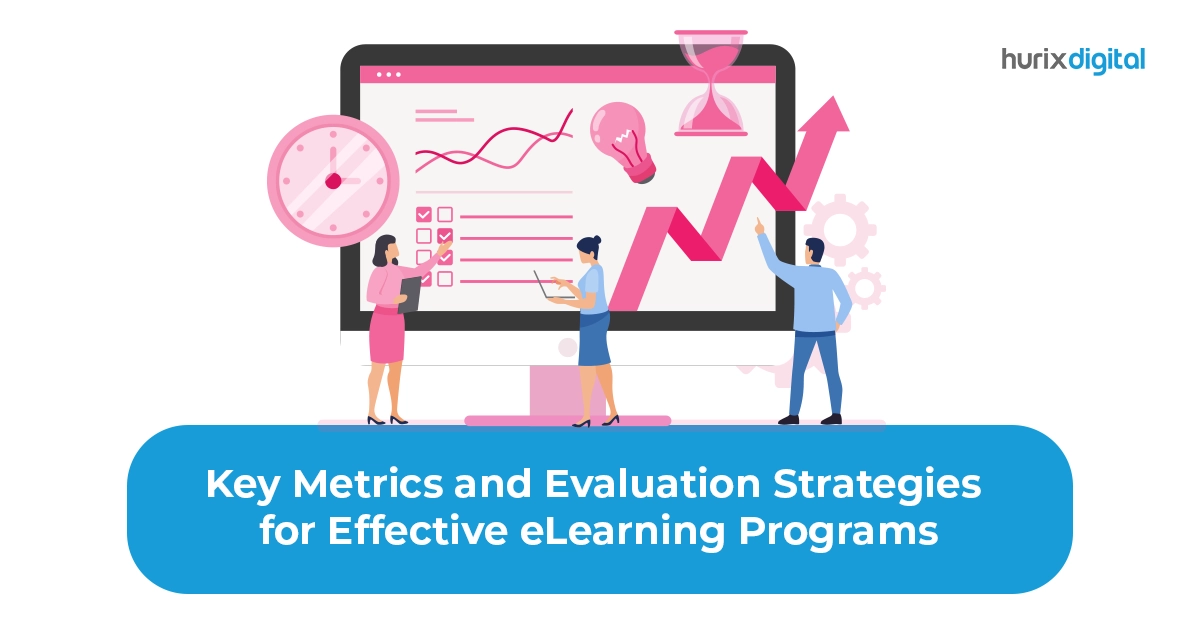
Key Metrics and Evaluation Strategies for Effective eLearning Programs
As technology evolves, continuous learning and honing your skills have become the bare minimum. To keep up with this competition, businesses must introduce accessible and efficient enterprise learning programs for their employees.
Setting up corporate eLearning programs hasn’t been easy, but eLearning solutions have made it possible. Employees can learn at their own pace, from anywhere, on any device. But how do you measure the success of your corporate eLearning program?
Here, we will discuss and outline everything related to enterprise learning, from identifying key metrics to providing you with strategies for effective evaluation.
Table of Contents:
- Why is Measuring the Success of Your Enterprise Learning Program Important?
- Enhancing Learner Experience to Optimize Corporate Learning Metrics
- Key Metrics for Measuring Enterprise Learning Program Success
- Strategies for Effective Evaluation of Enterprise Learning Program
- Conclusion
Why is Measuring the Success of Your Enterprise Learning Program Important?
Your enterprise learning program’s success should be kept in check for a lot of reasons.
eLearning services help you identify areas for improvement and assess the impact of your training programs on learners.
- These programs can reduce learning time by up to 40-60% compared to traditional in-person or physical learning methods.
- It allows you to demonstrate to stakeholders how their investment in your learning has paid off.
- The program ensures that your employees gain the skills and knowledge necessary to perform their jobs effectively.
- It is expected to experience a significant growth of over 250% by the year 2026.
- When you keep your staff updated about emerging technologies and market advancements, you can make sure you’re ahead in the competition.
Also Read: The Importance of Accessibility in eLearning: Strategies for Inclusive Training
Enhancing Learner Experience to Optimize Corporate Learning Metrics
For L&D programs, your primary goals majorly involve upskilling your workforce and delivering the required business results.
However, even the most carefully designed programs might fail to keep your workforce engaged. Therefore, improving engagement and learner experience is crucial for optimizing corporate learning metrics and long-term organizational goals.
1. Implement Personalized Learning Paths
In eLearning, personalization is revolutionary. Your employees’ diverse requirements may not be met by a one-size-fits-all approach, which could lead to disengagement and poor performance.
Actionable Insights:
- Use adaptive learning technologies to customize content based on individual performance and learning preferences.
- Provide optional modules or advanced resources for employees seeking to deepen their expertise.
- Enable learners to set personalized goals and track their progress through a dashboard.
Personalized learning paths improve learner satisfaction and completion rates—two critical corporate learning metrics that reflect the overall success of your training program.
2. Leverage Microlearning for Increased Engagement
Microlearning will provide your employees with crisp and targeted modules, designed to help them absorb and retain information without feeling anxious.
Actionable Insights:
- Divide intricate subjects into short lessons that can be finished within 5-10 minutes.
- Use microlearning to provide training right when employees need immediate assistance or skills.
- Emphasize essential concepts through spaced repetition and follow-up assessments.
Microlearning enhances completion rates and decreases the duration of completion, both of which positively influence your LMS metrics and the overall efficiency of the program.
3. Embrace Mobile Learning
Employees in today’s hybrid workplace need flexible access to training materials. Your staff may engage with the information at any time and from any place thanks to mobile learning.
Actionable Insights:
- Make content that fluidly adapts to various screen sizes and is mobile-responsive.
- Give employees offline access to essential training materials so they may continue learning even in the event of an internet outage.
- Make use of mobile-specific features, such as push notifications, to notify students of impending due dates or newly released material.
4. Encourage Social Learning
Social learning comes naturally to humans. Peer-to-peer interaction options can greatly improve student engagement and retention of information.
Actionable Insights:
- Establish chat rooms, discussion boards, or online communities so that staff members can cooperate and exchange ideas.
- To create a culture of ongoing learning, promote mentoring and peer review.
- Track collaboration and participation by integrating social learning platforms with your learning management system.
Social learning fosters a sense of belonging and teamwork, which improves learner satisfaction and retention rates and is a crucial learning metrics for evaluating eLearning.
Key Metrics for Measuring Enterprise Learning Program Success
There are plenty of metrics available. Here are some of the key metrics you can look for:
1. Completion Rates
Completion rates measure the percentage of employees who have completed a training program. This metric indicates the engagement and effectiveness of your training.
Completion rates consist of the number of employees who took the program, the final number who completed it, and the percentage of employees who finished it.
High completion rates can be helpful because they indicate that your workforce learning is engaging and effective, which can lead to better employee performance and job satisfaction. Interestingly, eLearning adoption has been shown to boost employee engagement by approximately 18%.
2. Assessment Scores
The information and skills that employees acquire after completing a training program are measured by assessment scores. This indicator demonstrates how well your training produced the desired results.
The total score, the percentage of questions answered correctly, and the quantity of questions answered properly are important factors in evaluation scores.
High test scores can be helpful since they show how well your training is working to achieve the desired results. Employee performance and job satisfaction increase as a result.
3. Cost per Learner
The cost per learner calculates the cost of offering a training program per learner. This is an important metric because it shows how efficient your program is and its cost-effectiveness.
The program’s overall cost, the number of students, and the cost per learner are important factors in cost per learner.
Lower costs per learner can be helpful as it signals that your enterprise learning program is cost-effective and efficient, potentially resulting in improved ROI and savings.
4. Learner Satisfaction
Employee satisfaction with your corporate learning program is gauged by learner satisfaction. From the viewpoint of the employee, this indicator illustrates the effectiveness and level of involvement of your training.
Surveys, feedback forms, and other direct staff input are important components of learner satisfaction.
Impactful and engaging training makes learners happier, which may raise employee morale. Remarkably, eLearning is used for staff training at about 40% of well-known businesses, including numerous Fortune 500 enterprises.
5. Retention Rates
Retention rates measure the percentage of employees who retain the knowledge and skills gained from the program over time, thus indicating the long-term effectiveness of your training.
Key components of retention rates include follow-up surveys, performance evaluations, and other forms of assessment.
High retention rates demonstrate the effectiveness of your training program in creating long-term learning outcomes. It can boost job security, stability, consistency, and employee development.
6. Time to Completion
Time to completion calculates how long it takes staff members to finish a training course. It draws attention to how effective and engaging your training is.
The average time to completion, the number of hours spent on each module, and the total number of hours spent in the program are important factors in time to completion.
Reduced completion times are a sign of effective and interesting training. Employees are more productive and experience less stress as a result, which can increase their general well-being and job satisfaction.
7. Return on Investment (ROI)
ROI calculates the monetary return on your investment in eLearning. This measure illustrates the entire efficacy of your instruction and focuses on the financial viewpoint.
The program’s overall cost, the total amount of money saved or earned, and the ROI % are important elements of ROI.
A high return on investment is important because it shows that your training is successful in reaching its goals and is a wise investment, which improves financial performance and reduces costs.
Strategies for Effective Evaluation of Enterprise Learning Program
The following tactics will assist you in conducting an efficient assessment of your workplace learning program:
1. Pre and Post-Training Assessments
By comparing your staff’s knowledge and skills before and after a program, you can ensure that your training is effective and identify areas for growth.
To properly implement this strategy, you ought to:
- Establish precise goals for your pre- and post-training evaluations.
- Select suitable evaluation instruments, such as questionnaires or quizzes, to gauge the intended results.
- Make sure that the tests are given fairly and uniformly.
- Examine the assessment results to see what needs to be improved.
2. Learning Analytics
Learning analytics is another effective strategy for evaluating enterprise learning programs. Data and analytics can help you identify trends, patterns, and areas for improvement in your training.
To implement this strategy properly, you should:
- Collect and analyze data on your corporate learning program, such as completion rates, assessment scores, and learner engagement.
- Use this data to identify areas for improvement, such as outdated content or areas where learners are struggling.
- Make data-driven decisions to improve your eLearning program based on the insights gained from your analysis.
3. Feedback from Learners
Getting input from your students will help you pinpoint areas that need work and adjust your instruction accordingly.
To properly implement this strategy, you ought to:
- Allow pupils to express their thoughts by using questionnaires or focus groups.
- Look for reoccurring themes and areas that want improvement by going over the comments.
- Based on this input, modify your eLearning program by improving the user interface or altering the course materials.
4. Continuous Evaluation
Continuous evaluation is the practice of continuously reviewing your workforce learning program to ensure its success and achievement of goals. With time, this data will help you customize training programs to ensure every employee gets trained to resolve their pain points.
To execute this strategy successfully, you should:
- Choose a regular evaluation time, like quarterly or annually, for your eLearning program.
- Utilize a variety of assessment methods, such as learner feedback, learning analytics, and tests that are administered before and after training.
- Utilize the evaluation’s insights to inform data-driven decisions that will improve your eLearning program.
Also Read: Crafting Your eLearning Journey: 7 Simple Steps to Course Development
Conclusion
Measuring the success of your corporate eLearning program is essential for ensuring that your employees are gaining the necessary skills and knowledge to perform their jobs effectively.
When you consciously choose appropriate KPIs and implement sound evaluation techniques, you ensure that your organization’s learning programs are effective and successful. Concentrating on program success may drive business growth and success.
Hurix Digital can help measure eLearning success by offering customized solutions for enterprise, workforce, and corporate learning, incorporating adaptive learning techniques and robust evaluation strategies. Feel free to contact our team for further details.

Performance, Results, Growth, and Life-Long Learning define my professional life. I am passionate about making workplace learning planful, purposeful, and impactful. I take pride in partnering with clients and bringing them the best in learning design and creating solutions that address business challenges.
 A Space for Thoughtful
A Space for Thoughtful 



